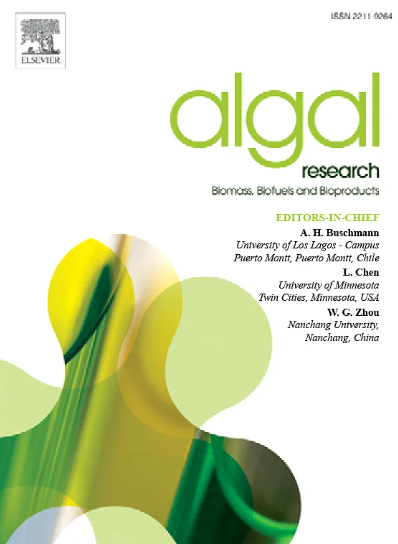揭示了淡水丝状藻类作为必需脂肪酸和生物活性类胡萝卜素的有前途的替代来源的潜力
IF 4.5
2区 生物学
Q1 BIOTECHNOLOGY & APPLIED MICROBIOLOGY
Algal Research-Biomass Biofuels and Bioproducts
Pub Date : 2025-05-19
DOI:10.1016/j.algal.2025.104100
引用次数: 0
摘要
开发一种富含必需脂肪酸(EFAs)和其他生物活性化合物的可持续和具有成本效益的食品来源,同时最大限度地减少对环境的影响,仍然是当今的重大挑战。在这方面,与单细胞微藻相比,丝状藻类更容易收获,成本更低,使大规模生产生物质和生物活性化合物更加环保。本研究探讨了淡水丝状藻类作为增值产品,特别是EFAs和生物活性色素的有前途的来源的潜力。本研究对汉堡微藻和Zygnematophyceae Collection (MZCH)中的91株丝状藻类进行了初步筛选,筛选出生长速率较高的菌株。选择11个有希望的候选物进行进一步的生化评价。细胞尺寸为长5.8 ~ 117.2 μm,宽6.4 ~ 56.7 μm。这种细胞大小的可变性增强了它们对特定应用的适用性,例如纺织工业,在纺织工业中,较大的长丝可以直接用于生产生物基纤维、纱线和织物。其中,foveolatum odogonium foveolatum和Spirogyra sp. #771的生物量(干重)最高,分别为0.70和0.67 g L−1。在高附加值产品中,透明胶(Hyalotheca dissiliens)的碳水化合物含量最高,为干重的56.4±2.32% (dw%),而多孢茅(Mougeotiopsis calospora)的蛋白质含量最高,为48.0±2.19 dw%。总生物活性类胡萝卜素(tBC)含量最高,为11.5±0.05 mg g−1 dw, tBC浓度最高,为4.03±0.16 mg L−1。有趣的是,忽略格林布氏虫的脂肪含量最高,为34.4±1.59 dw%, EFAs含量最高,为14.3±0.46 dw%。它还实现了3.57±0.03的平衡ω-6/ω-3比值,这是膳食应用的最佳选择。目前的研究表明,在上述生长条件下,G.忽略菌是开发富含efa的可持续食物来源的有希望的候选植物,值得进一步的研究和开发。本文章由计算机程序翻译,如有差异,请以英文原文为准。

Unveiling the potential of freshwater filamentous algae as a promising alternative source of essential fatty acids and bioactive carotenoids
Developing a sustainable and cost-effective food source enriched with essential fatty acids (EFAs) and other bioactive compounds, while minimizing the environmental impact, remains a significant challenge nowadays. In that regard, filamentous algae can be harvested more easily and at a lower cost compared to unicellular microalgae, making large-scale production of biomass and bioactive compounds more eco-friendly. The present study explores the potential of freshwater filamentous algae as a promising source for value-added products, particularly EFAs and bioactive pigments. The study involved an initial screening of 91 filamentous algae strains from the Microalgae and Zygnematophyceae Collection Hamburg (MZCH) to identify isolates with high growth rate. Eleven promising candidates were selected for further biochemical evaluation. Cell dimensions showed 5.8–117.2 μm length and 6.4–56.7 μm width. This variability in cell size enhances their suitability for specific applications, such as textile industry, where larger filaments can be directly utilized in producing bio-based fibers, yarns and fabrics. Among the studied algae, Oedogonium foveolatum and Spirogyra sp. #771 showed the highest biomass concentration (dry weight) of 0.70 and 0.67 g L−1, respectively. Regarding value-added products, Hyalotheca dissiliens showed the highest carbohydrate content of 56.4 ± 2.32 % of dry weight (dw%), while Mougeotiopsis calospora showed the highest protein content of 48.0 ± 2.19 dw%. Klebsormidum nitens showed the highest total bioactive carotenoids (tBC) content of 11.5 ± 0.05 mg g−1 dw and the highest tBC concentration of 4.03 ± 0.16 mg L−1. Interestingly, Groenbladia neglecta stood out with the highest recorded lipid content of 34.4 ± 1.59 dw% and EFAs content of 14.3 ± 0.46 dw%. It also achieved a balanced ω-6/ω-3 ratio of 3.57 ± 0.03, which is optimal for dietary applications. The present study suggests G. neglecta under the mentioned growth conditions as a promising candidate for developing sustainable EFA-rich food sources, warranting further research and development.
求助全文
通过发布文献求助,成功后即可免费获取论文全文。
去求助
来源期刊

Algal Research-Biomass Biofuels and Bioproducts
BIOTECHNOLOGY & APPLIED MICROBIOLOGY-
CiteScore
9.40
自引率
7.80%
发文量
332
期刊介绍:
Algal Research is an international phycology journal covering all areas of emerging technologies in algae biology, biomass production, cultivation, harvesting, extraction, bioproducts, biorefinery, engineering, and econometrics. Algae is defined to include cyanobacteria, microalgae, and protists and symbionts of interest in biotechnology. The journal publishes original research and reviews for the following scope: algal biology, including but not exclusive to: phylogeny, biodiversity, molecular traits, metabolic regulation, and genetic engineering, algal cultivation, e.g. phototrophic systems, heterotrophic systems, and mixotrophic systems, algal harvesting and extraction systems, biotechnology to convert algal biomass and components into biofuels and bioproducts, e.g., nutraceuticals, pharmaceuticals, animal feed, plastics, etc. algal products and their economic assessment
 求助内容:
求助内容: 应助结果提醒方式:
应助结果提醒方式:


